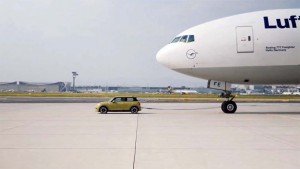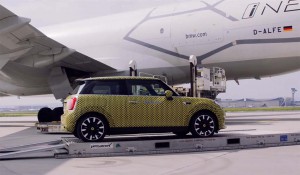Tell most folks you want to buy an EV and they’ll likely picture a slow and stodgy vehicle that can barely get out of its way.
That image is changing, thanks to the Tesla Model S with Ludicrous Mode, as well as some of the new battery-electric supercars like the new Pininfarina Battista. But there were clearly some folks shocked when they realized what you could pull off stuffing an electric drive system inside a Mini.
The British arm of BMW is kicking off an ad campaign teasing the all electric Mini Cooper SE it will launch later this year by showing it towing a 150-ton Boeing 777F freight jet at the airport in Frankfurt, Germany.
Mini isn’t ready to reveal much about the new three-door battery-car but what we do know about electric motors is that they generate tremendous torque almost instantaneously, a perfect solution if you just happen to have a big jet you need to pull somewhere.
(Mini’s new John Cooper Works models ascend to new levels. Click Here for the story.)

The immediate torque available from the all-electric Mini Cooper SE is just what's needed to tow a jetliner.
The Brits have been teasing the upcoming all-electric model for several years and, in a new press release said the “First purely electrically powered model made by the British premium manufacturer is to be produced at the Mini plant in Oxford starting in November 2019. That would likely mean a U.S. launch won’t happen until spring 2020 or even a bit later.
Underneath the yellow-and-black camouflage, the Mini electric will be all but identical to the current Mini Cooper Hardtop, save for subtle tweaks to the grille and wheels, the lack of tailpipes and a battery charging port, rather than a cover for the gas filler.
Under the skin, however, the SE is expected to share the same drivetrain as in the latest version of the BMW i3. If that holds accurate, it will feature a 33.8 kilowatt-hour lithium-ion battery capable of delivering around 114 miles of range using the EPA certification, rather than the more lenient European test. There is the possibility that Mini might even sneak in a longer-range battery. We’ve already seen BMW upgrade the battery in the i3.
(Click Here for details about the early version of the Mini EV.)
One big difference from the BMW city car is that the Mini Cooper SE drivetrain will power the front, rather than the rear, wheels.

Mini's planning to being prosecution of it new EV in November 2019, which means it's unlikely any will hit the U.S. until early next year.
One of the other questions we’ll look to have answered later this year is whether the Mini electric also will feature a range-extending gas engine, like the one used in the BMW i3. For the U.S. market, however, that would seem critical. While 114 miles is more than enough to handle the typical daily driving needs of American motorists, research has shown that this still creates plenty of range anxiety. Most drivers now expect to get at least 200 miles per charge – or to have a range-extender onboard to let the vehicle keep going when the batteries run down.
Mini actually tinkered with an all-electric model earlier in the decade in prototype form. Company officials claim they learned a lot about customer expectations and, among other things, that will be reflected by having two different regenerative braking modes. The original Mini Electric slowed quite aggressively. That was good for motorists who like “one-pedal” driving, but too much for the average owner. The production SE is expected to give drivers a choice.
(Mini shows off battery-electric concept at Goodwood. Click Here for the story.)
As for pricing, the base BMW i3 starts at $44,450, a figure that jumps to $48,300 for the range-extender version. The Mini Cooper SE is expected to fall roughly in line with its German counterpart.


I’m unhappy that the images from an LA photo shoot show the Mini Cooper S E with the hood scoop from the Mini Cooper S. The better looking Mini Electric concept car didn’t have a hood scoop. There is no need to get more air to the fuel injectors on this car.
We’ll probably hear that the non-functional hood scoop was added to demonstrate that the Mini Cooper S E is, indeed, a Cooper S rather than a lesser model.